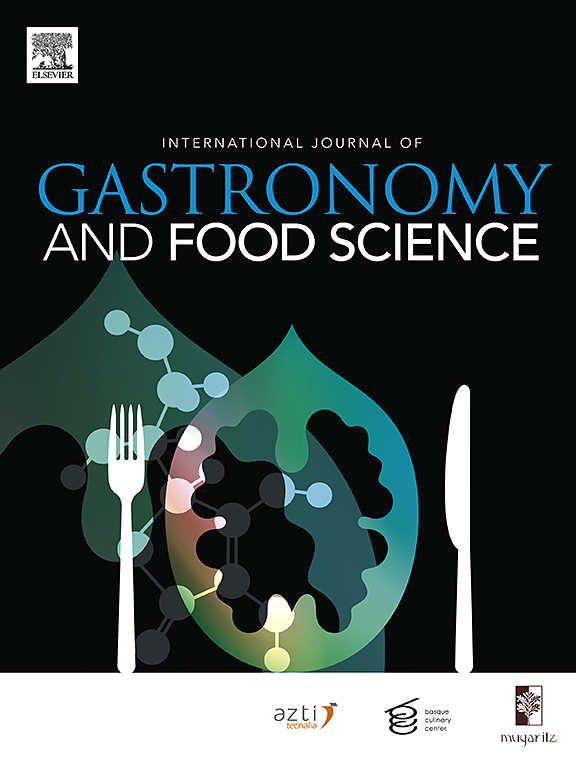Optimization of fermentation process for maximized isothiocyanate content in kohlrabi pickle
IF 3.6
2区 农林科学
Q2 FOOD SCIENCE & TECHNOLOGY
International Journal of Gastronomy and Food Science
Pub Date : 2025-07-06
DOI:10.1016/j.ijgfs.2025.101243
引用次数: 0
Abstract
Fermented kohlrabi, known as Mounji achar, is an indigenous fermented food product of the Himalayan region of J&K, India. The present study explored the influence of three fermentation parameters-temperature, time, and salt concentration on the formation of health-promoting compounds, isothiocyanates (ITC). Box Behnken design was used to optimize the traditional fermentation process. The second-order polynomial model exhibited a strong correlation with the experimental data, effectively predicting responses in terms of total ITC content (R2 = 0.98, p < 0.0001), pH (R2 = 0.98, p < 0.0001), and titratable acidity (R2 = 0.96, p = 0.0002). The optimal conditions identified for maximizing isothiocyanate formation were a fermentation temperature of 29.83 °C, a fermentation time of 180.66 h, and a salt concentration of 2.48 %. Furthermore, HPLC was used to quantify two isothiocyanate molecules, erucin and phenethyl isothiocyanate, individually. Moreover, the optimized Mounji Achar presented a viable Lactic Acid Bacteria (LAB) population. 16 s rDNA sequencing revealed a diverse microbial community, including Lactiplantibacillus, Limosilactobacillus, and Bacillus species. This study sheds light on the potential for optimizing fermentation conditions to enhance total isothiocyanate content and the development of a product with a beneficial microbial profile, contributing to its nutritional and potential probiotic value.

大头菜泡菜中异硫氰酸酯含量最大化的发酵工艺优化
发酵大头菜,被称为Mounji achar,是印度喜马拉雅地区的一种本土发酵食品。本研究探讨了温度、时间和盐浓度三个发酵参数对促进健康的化合物异硫氰酸酯(ITC)形成的影响。采用Box Behnken设计对传统发酵工艺进行优化。二阶多项式模型与实验数据表现出较强的相关性,可以有效地预测总ITC含量的反应(R2 = 0.98, p <;0.0001), pH (R2 = 0.98, p <;0.0001),可滴定酸度(R2 = 0.96, p = 0.0002)。发酵温度为29.83℃,发酵时间为180.66 h,盐浓度为2.48%,能最大限度地提高异硫氰酸酯的产量。此外,采用高效液相色谱法分别定量了两个异硫氰酸分子,即芥子素和异硫氰酸苯乙酯。此外,优化后的蒙鸡乳酸菌(monji Achar)具有一定的活菌群。16s rDNA测序显示微生物群落多样,包括乳酸杆菌、乳酸杆菌和芽孢杆菌。这项研究揭示了优化发酵条件以提高总异硫氰酸盐含量的潜力,并开发了具有有益微生物特征的产品,有助于其营养和潜在的益生菌价值。
本文章由计算机程序翻译,如有差异,请以英文原文为准。
求助全文
约1分钟内获得全文
求助全文
来源期刊

International Journal of Gastronomy and Food Science
Social Sciences-Cultural Studies
CiteScore
5.30
自引率
10.50%
发文量
170
审稿时长
45 days
期刊介绍:
International Journal of Gastronomy and Food Science is a peer-reviewed journal that explicitly focuses on the interface of food science and gastronomy. Articles focusing only on food science will not be considered. This journal equally encourages both scientists and chefs to publish original scientific papers, review articles and original culinary works. We seek articles with clear evidence of this interaction. From a scientific perspective, this publication aims to become the home for research from the whole community of food science and gastronomy.
IJGFS explores all aspects related to the growing field of the interaction of gastronomy and food science, in areas such as food chemistry, food technology and culinary techniques, food microbiology, genetics, sensory science, neuroscience, psychology, culinary concepts, culinary trends, and gastronomic experience (all the elements that contribute to the appreciation and enjoyment of the meal. Also relevant is research on science-based educational programs in gastronomy, anthropology, gastronomic history and food sociology. All these areas of knowledge are crucial to gastronomy, as they contribute to a better understanding of this broad term and its practical implications for science and society.
 求助内容:
求助内容: 应助结果提醒方式:
应助结果提醒方式:


